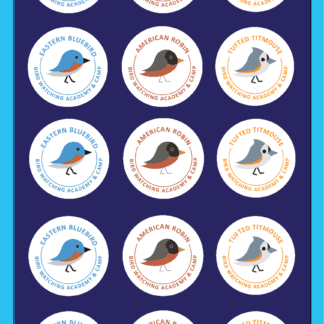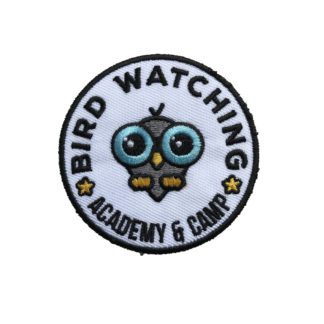
Killdeer
A Killdeer is a fun bird to see while bird watching. Below are some tips to help you identify Killdeers. We have also put together a list of fun Killdeer t-shirts, Killdeer bird patches, bird houses, bird feeders, binoculars, stickers and other fun bird watching items.
About Killdeers
The Killdeer is a medium-sized shorebird commonly seen on lawns, golf courses, fields and parking lots. They are graceful and belong to the plover family of birds which are mainly considered as waders. They are very noisy birds who despite being shorebirds, they are often seen on dry and flat landscapes. Their numbers have been declining in urban areas although still abundant and widespread. The Killdeer is native to North America with their breeding grounds in Canada.
Description and Identification
Killdeers’ upperparts are mostly brown with rufous fringes and have a short, thick, and dark bill. The birds have a white forehead and a white stripe behind the eye, and their lives and the upper borders to the white forehead are black. While the rest of their face is brown, they have a white collar with a black upper border. Their rump is red, and the tail is mostly brown. The female Killdeers’ mask and breast bands tend to be browner than those of male killdeers. The juvenile Killdeers are similar to that of adults, and the upper parts of the chick are coloured dusky and buff. Their underparts, forehead, neck, and chin are white.
Killdeer Color Pattern
It has a short and dark bill and flesh colored legs. The upperparts are mostly brown coupled with fringed rufous while their eyes are surrounded by a red ring. The chest and belly are white with a double black line running through the chest. The head is brown and the neck is white. It also has a white line running behind the eye.
Killdeer Size
Their lengths range between 20-28cm and have a wingspan of 59-63cm. They usually weigh between 72-121g. This makes them a fairly large bird.

Killdeer Behavior
They can be seen on land running in small spurts and often halting to look around probably to note whether they have spurred up some insects. They are shy birds despite being seen around the human habitat. When spooked, they tend to run first before taking flight.
When defending their territory, they have a habit of bopping up and down while looking for intruders. In the eventuality that they spot an intruder, they let off a loud call while bopping then run away.
What Killdeer Eat and Their Food
Killdeers primarily feed on insects, especially beetle, caterpillars, grasshoppers, fly larvae, and flies, in addition to millipedes, worms, snails, spiders, and some seeds. They are often known to be opportunistic foragers; Killdeers are seen hunting frogs and eating dead minnows. Occasionally, Killdeers feed on small vertebrates and seeds. Killdeers use visual cues to forage almost exclusively in fields, especially those with short vegetation and with cattle and standing water. Killdeers farmers’ plough in hopes of retrieving any unearthed worms or insect larvae.
Insects are the preferred choice of food. They include caterpillars, beetles, grasshoppers and fly larvae among others. Crayfish and snails are also on their diet as well as a few amounts of seeds.
Where Killdeers Live and Their Habitat
Killdeers are found in a variety of open habitats such as fields, meadows, gravel bars, and mudflats throughout the United States and most of Canada. They are often seen on open ground, such as pastures, ploughed fields, large laws, even at a great distance from water. They are probably most familiar around towns, where they live on lawns, driveways, athletic fields, parking lots, airports, and golf courses. The birds require a sandy or gravelly substrate for nesting near a muddy or wet area where Killdeers can forage. The birds are also found in upland areas far from water.
The Killdeer is common to fields, airports, mudflats, shores, and river banks but they are often be found on open ground like ploughed fields and lawns.
Range and Migration

Killdeers breed from southeastern Alaska and southern Canada to Mexico. They are seen year-round in the southern half of its breeding; they are residents in the West Indies and inhabit Peru and areas of the surrounding countries throughout the year. North Indian breeders winter from their resident range south to Central America, the West Indies, and the northernmost portions of South America. Killdeers breed in The US, including southeastern Alaska, southern Canada, and Mexico, with less widespread grounds further south to Panama. They are either residents or medium-distance migrants. Few northern birds spend the winter in Mexico. In Pacific Coast and the southern United States, Killdeers are year-round residents. Migrating birds return in February and March and stay until October or November.
Nesting
Killdeers form pairs on their breeding ground right after arriving, and both the sexes advertise in flight with the loud “killdeer” calls. Inbreeding season, male flies high over nesting territory in floating, wavering flight, slow, deep wingbeats, and repeatedly giving the kill-dee call. Nest site is on the ground in open areas with good visibility, like bare soil, short-grass field, gravel road, and gravel roof. Female Killdeers typically lay four eggs, and both sexes incubate, with male Killdeers incubate more often at night. The younger Killdeers are precocial and are taken care of by both parents.
Killdeer Lifecycle
Female Killdeers lay 4 eggs. Incubation is done by both the male and the female and takes 24-28 days to hatch. The young ones are fed by both parents till they leave the nest 25 days after hatching. Their lifespan is about 11 years.
Ornithology
Bird Watching Academy & Camp Subscription Boxes
At Bird Watching Academy & Camp we help kids, youth, and adults get excited and involved in bird watching. We have several monthly subscription boxes that you can subscribe too. Our monthly subscription boxes help kids, youth, and adults learn about birds, bird watching, and bird conservation.
Bird Watching Binoculars for Identifying Killdeers
The most common types of bird watching binoculars for viewing Killdeers are 8×21 binoculars and 10×42 binoculars. Bird Watching Academy & Camp sells really nice 8×21 binoculars and 10×42 binoculars. You can view and purchase them here.
Killdeer T-shirts
If you love the Killdeer you should purchase a Bird Watching Academy & Camp T-shirt. To help support bird conservation we donate 10 percent to bird conservation activities.
Killdeer Iron On Patches
Kids, Youth, and Adults love to collect our Bird Watching Academy & Camp iron on patches. Our bird watching patches help you keep track of the birds you have seen an identified. You can also display the patches on our Bird Watching Academy & Camp banners.
The Killdeer is a great iron on patch to start your collection with. The patches are durable and can be sewn on or ironed on to just about anything.
Killdeer Stickers
Stickers are a great way for you to display your love for bird watching and the Killdeer. We sell a monthly subscription sticker pack. The sticker packs have 12 bird stickers. These sticker packs will help your kids learn new birds every month.
Bird Feeders For Killdeer
There are many types of bird feeders. Here are our favorite bird feeders for your backyard. We use all of these bird feeders currently. Kids will have a great time watching birds eat at these bird feeders. Using this collection of bird feeders will provide a wide variety and many types of birds.
Best Bird Houses for Killdeer
There are many types of bird houses. Building a bird house is always fun but can be frustrating. These 4 bird houses have become our favorites. Getting a bird house for kids to watch birds grow is always fun. We spent a little extra money on these bird houses but they have been worth the higher price and look great.





































